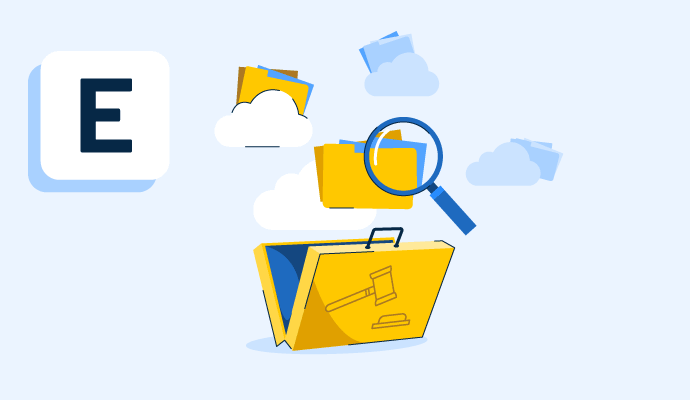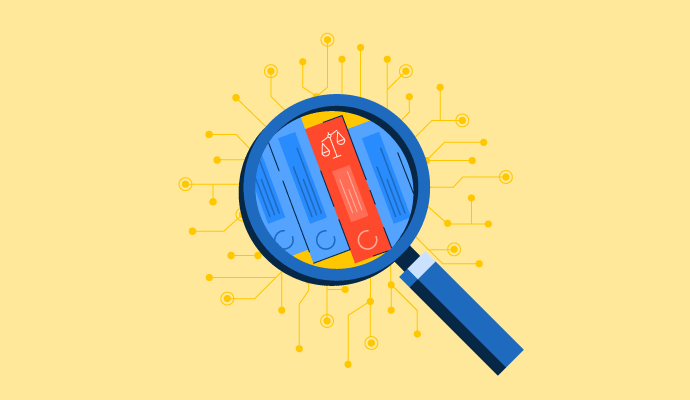What is eDiscovery?
Since the majority of evidence in legal cases is now stored electronically, eDiscovery has become an essential component of modern legal practice. Conducting eDiscovery requires specialized expertise and technology in order to review electronically stored documents
Professionals use eDiscovery software to examine electronic documents and information during litigation. The purpose of eDiscovery is to find, preserve, collect, review, and produce electronically stored information (ESI) that may be relevant to a legal or regulatory investigation.
ESI includes emails, instant messages, text messages, social media posts, videos, audio files, documents, and other types of electronic data. eDiscovery is important because electronic data has become the primary means of communication and information storage in today's world.
Types of eDiscovery
Companies generally rely on two types of eDiscovery. Both require careful planning, management, and execution so relevant data is collected and analyzed in an efficient manner. Organizations may need to work with external eDiscovery vendors or consultants to help manage these processes, particularly in cases involving large volumes of data or complex technical issues.
- Proactive eDiscovery involves the routine and ongoing collection, processing, and analysis of electronic data to manage potential risks, such as data breaches or regulatory violations.
- Reactive eDiscovery is the more traditional form of eDiscovery, which involves compiling and reviewing electronic data in response to a specific legal request or investigation. Reactive eDiscovery can be time consuming and expensive. It requires recognizing and accumulating potentially relevant data from various sources, processing and analyzing the data, and producing it in a format that is admissible in court.
Benefits of eDiscovery
eDiscovery can help organizations more effectively manage the discovery process, reduce costs and risks, and improve their overall litigation and risk management strategies. Below are some common benefits of eDiscovery.
- Accuracy: eDiscovery tools and techniques guarantee that electronic data is collected and analyzed accurately and comprehensively, reducing the risk of missing important information or making errors in the discovery process.
- Accessibility: Electronic data can be easily searched, sorted, and analyzed so it’s easier for organizations to extract relevant information from large volumes.
- Compliance: Businesses turn to local and federal laws to maintain compliance with legal and regulatory requirements for preserving and producing electronic data, reducing the risk of sanctions.
- Risk management.: Managing potential risks related to data privacy, security, and compliance and reducing the risk of data breaches, regulatory violations, or other legal issues are contained under the umbrella of risk management.
- Litigation strategy. eDiscovery enables organizations to build a more effective litigation strategy by identifying key documents and evidence, assessing the strength of their case, and evaluating potential settlement options.
eDiscovery process
Initially, the process of retrieving and reviewing electronically stored information made scarce use of eDiscovery software. But as technology became more pervasive in daily life and the workplace, solutions expanded to include the entire eDiscovery process. A sizable market has been created due to the rise in comprehensive solutions and the acceptance of electronic files, as evidenced by the legal system.
- Information governance (IG): IG is managed by the information governance reference model (IGRM), which offers a framework that agencies can adhere to. IG describes the processes, policies, and controls for data collection.
- Identification: Evidence preservation is essential for a successful trial. Teams work on the identification phase by speaking with important stakeholders, reviewing the case facts, and examining digital evidence to determine which data should be preserved. A legal hold is put on a file once it has been determined that it’s pertinent to a case. The files cannot be deleted, destroyed, or altered in any way. After the files are subject to a legal hold, the eDiscovery software identifies those that may be relevant, removes them, and stores them in a database.
- Preservation: Once the pertinent data has been located, owners safely preserve the information. The program scans the files, then separates the salient and irrelevant information. The pertinent files are stored in a safe digital location.
- Data collection: Depending on the needs, data collection can be done using various technologies, but the application must adhere to legal procedures. Digital evidence and data should not be compromised or changed.
- Processing: After data has been gathered, it may not be organized and cannot be presented in its current form to the court's attorneys. Automated eDiscovery software, data organization, and processing can all aid in ensuring relevancy and the extraction of useful information. Some documents are converted to a different file format, frequently a PDF, to remove privileged information. Redactions can prevent irrelevant information from being viewed in an otherwise relevant file.
- Review: Examining and recording the data before presenting it is crucial. The reviewing process can be carried out manually or with artificial intelligence. This step identifies the documents that are protected by the client-attorney privilege. Lawyers and paralegals review the paperwork.
- Analysis: Data sorting by topic allows for seeing patterns and the overall context at this stage. Stored information (SI) is assessed in context and content, including important trends, discussions, and individuals.
- Production: During this stage, information is delivered to the adversary in the format requested per the predetermined delivery schedule and strategy. By this point, the information should be organized, thoroughly examined for privilege and relevance, and culled so that it’s not cumulative or redundant.
- Presentation: Electronically stored information (ESI) is shown to audiences during depositions, hearings, trials, etc., particularly in native forms like making tutorial videos, etc. and near-native forms to elicit additional information and confirm already-held beliefs or positions.
eDiscovery vs. digital forensics
The process of locating and securing ESI to use it in a legal proceeding is known as eDiscovery. It typically entails data analysis and examining vast volumes of documents or other data types.
Each case has a unique eDiscovery procedure and objective. A wide range of issues may be covered by eDiscovery, from corporate investigations into fraud to legal cases involving intellectual property disputes, employment claims, or shareholder disputes. These techniques are also applied in compliance cases involving antitrust, environmental, or privacy laws. As businesses conduct their due diligence during mergers and acquisitions, they frequently use an eDiscovery procedure to review documents.
Digital forensics is the application of scientific techniques toward the preservation, collection, validation, identification, analysis, interpretation, documentation, and presentation of ESI as a probe component into illegal activity. Digital forensics calls for a thorough understanding of many different investigative methods. Finding deleted files, and reconstructing timelines using artifacts like operating systems and web histories are typical.
Unlike digital forensics, eDiscovery does not explicitly address ESI that has been removed, altered, or concealed. On the other hand, digital forensics frequently enters the picture as soon as ESI is inaccessible or unavailable. Simply put, digital forensics aims to locate and enumerate ESI. As a result, compared to eDiscovery, digital forensics tends to be a more technical task that calls for different equipment, expertise, and training.
Learn more about digital forensics and explore ways to identify the cause of cybercrime.

Sagar Joshi
Sagar Joshi is a former content marketing specialist at G2 in India. He is an engineer with a keen interest in data analytics and cybersecurity. He writes about topics related to them. You can find him reading books, learning a new language, or playing pool in his free time.




















